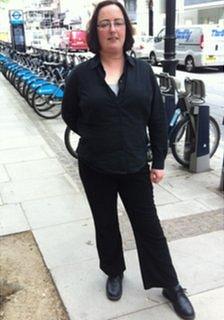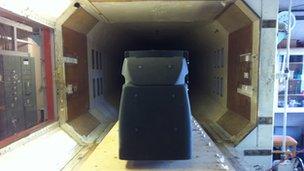New curvaceous lorries aim to save cyclists' lives
- Published
The BBC's Richard Westcott takes a look at the Concept S at MAN's Munich headquarters - footage filmed on a mobile phone
Lorry cabs have been shaped like an upturned shoebox for decades.
It's a terrible shape. Bad for fuel consumption and lethal in accidents, because the driver has blind spots and the flat front can push pedestrians and cyclists underneath the wheels.
It's hard to listen to Cait Hurley talk about the time she ended up under a lorry as she cycled home in London last year. "When I was on the ground, I assumed that everything from my knee down was gone," she says. "That's what it felt like. But I was alive."
She showed me her leg, which has extensive skin grafts and still hurts her a great deal. Sometimes she has to use a stick to walk. But she is able to talk about it, because she wants more done to protect cyclists from lorries.
"I only had time to think of two things, really. Where are the wheels. And my kids... oh, it's my turn, that's what I thought."

Cait Hurley knows from experience how dangerous lorries can be to cyclists
Now the European Commission says it wants to change the rules governing the size of lorries to help protect people like Cait.
Funnily enough, it involves making them bigger. Well, the cab at the front, anyway.
The commission wants to allow manufacturers to make more aerodynamic and curvaceous lorry cabs. Officials claim it will improve driver visibility, saving hundreds of lives across the EU every year, as well as cutting about £1,300 per lorry per year off the diesel bill for hauliers.
Ironically, the box-shaped cab that we have now is the result of well-meaning EU rules devised nearly 20 years ago. A size limit was introduced to protect our roads and bridges from huge vehicles.
There are exceptions but articulated lorries in the UK are generally no more than 16.5m long and 44 tonnes in weight. So to maximise the payload, the manufacturers have always squashed up the size of the cab.
Shape-shifting
If these new rules come in, designers who have been bored stiff drawing shoeboxes will be able to flex their brains on futuristic new shapes.
Shapes like Concept S, MAN's vision of a lorry of the future. From the front, it looks like Boba Fett , externalfrom Star Wars.
Stephan Kopp, MAN's senior manager for aerodynamic development, truck and bus, says it will be "a revolution". We had a chat while he drove me in around Munich in an HGV (he doesn't just design them, he can drive them too).

MAN's futuristic concept vehicle is the stuff of science fiction
"For several years now, we are trying to convince the European Union to allow us more freedom. If we are allowed to build longer trucks, then we can realise the potential in aerodynamics and safety."
Just like a modern car, Concept S is shaped to deflect a person away from the vehicle if there's an accident. Bigger windows, and cameras instead of mirrors, will clear up some of those blind spots too. And it'll drink less fuel.
All good then? Well, there is a twist in this story. The European Commission also wants to change the rules to allow 25m mega-trucks on the roads.
Individual governments will be able to opt out, and in fact the Department for Transport has told me that, although there is a longer lorry trial going on in Britain right now, it still has no intention of letting much bigger trucks on to the roads.
But Prof David Cebon at Cambridge University says that in the end, ministers will probably have no choice. He is director of the Centre for Sustainable Road Freight, which combines academics with industry players, all looking for ways to make road deliveries greener.
We had a chat next to his wind tunnel, which has a spooky black model of a lorry inside (think Knightrider, but covered in little bits of string).
Monster trucks?
Prof Cebon says people should not be worried about mega-trucks, as long as the drivers get the right training,

The Centre for Sustainable Road Freight has its own wind tunnel
"The experience in Australia is that these larger, heavier vehicles have a far better safety record than the vehicles they are replacing," he says.
"They are also much more fuel-efficient - you can reduce fuel consumption by 20 or 30%. They would also reduce the number of vehicles on the roads."
In the end, he argues, if lots of other EU countries allow longer lorries that can't then come to the UK, and businesses start losing out, the government will come under a lot of pressure to allow them here too.
Campaigners are very worried, though. William Todts, from Transport & Environment, an NGO, reckons new cabs are a great idea. Mega-trucks, he says, are not.
"Obviously it's not safer. Once an accident happens, the impact will be horrific. Of course, if you have the newest lorries with special safety equipment and well-trained, experienced drivers, you can reduce that risk. The reality in the trucking sector is that this is not the standard at all."
Back in London, Cait Hurley agrees that curvy cabs are a good thing. But she says it's not the answer to making the roads safer, "I think it's a thing to do, but it's not the thing to do. It's so important to get people on bikes we should be doubling the money we spend on cycle investment annually."
Let's face it. The European Union moves about as quickly as a fully laden HGV with gearbox problems making its way across the Lake District.
European politicians still have to approve the new rules. But it does look like we'll be seeing curvaceous lorry cabs on our roads within the next seven or eight years. They could well be pulling longer trailers, though.
Follow Richard on Twitter @richardwestcott